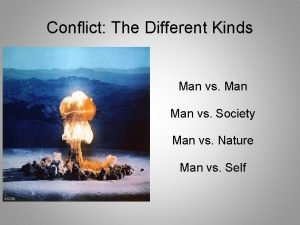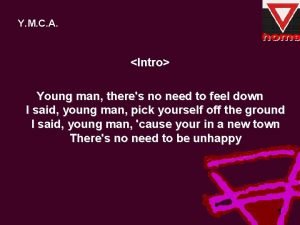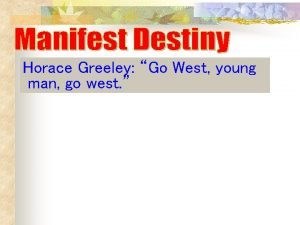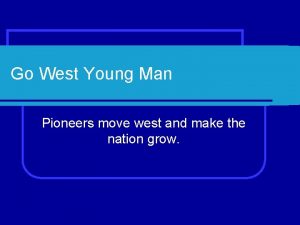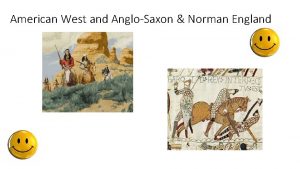The American West Go West Young Man The









- Slides: 9

The American West “Go West Young Man!”

The American West Massive movement west after the Civil War How did they get there? ◦ Wagons – inexpensive but very risky ◦ Railroads – upper class citizens, speed + leisure

The American West Why did people want to move to the American West? ◦ Land! – a new life, new hope…lots of it and cheap. Homestead Act – 160 free acres to “improve” Oklahoma land grab – get there “Sooner” rather than they were supposed to ◦ Gold! – 1858 (Colorado), 1878 (Dakota’s) Breckenridge, CO

The American West What was western life like? ◦ NOT “home, home on the range!” ◦ Droughts, floods, fires, Native Americans, locusts…rough life. ◦ Soddy Homes – prairie turf (like concrete) house ◦ Men and women HAD to be equal – chopping wood, shearing animals, harvesting crops

The American West Inventions help “modernize” the American West ◦ Railroad – connects the west with eastern markets ◦ Steel plow ◦ Barbed Wire – enclosure movement (no free range!) ◦ 1830 – one bushel of grain took 190 minutes ◦ 1900 – one bushel of grain took 10 minutes

The American West Lawlessness? ◦ Sure, there were outlaws and bandits…not nearly as bad as seemed ◦ Myth of Hollywood movies ◦ Cowboys – Marlboro man myth! Short, many were Mexican and/or African American, small in build

The American West Cowboys?

The American West Native American Affairs ◦ Clash of cultures continued… ◦ Government changes policy towards Native Americans; Native Americans resist ◦ Dawes Act – “Americanize” Native Americans, land, religion, schooling, etc. ◦ Sitting Bull – lone Sioux leader who doesn’t sign the Treaty of Fort Laramie ◦ Battle of Wounded Knee – end of an era, Sioux were destroyed, U. S. soldiers left to freeze

The American West Growth of American West allows for massive industrialization in cities Goods and services are produced in west and transported to markets Also, growth of country means more markets and areas for economic prosperity
 Man vs society literary definition
Man vs society literary definition The rich young man matthew
The rich young man matthew Garden archetype
Garden archetype Young person from the provinces archetype
Young person from the provinces archetype How can a young man cleanse his way
How can a young man cleanse his way Young man ymca
Young man ymca Supernatural intervention archetype
Supernatural intervention archetype Innate wisdom vs. educated stupidity examples
Innate wisdom vs. educated stupidity examples Brave young man
Brave young man One of the most effective vegetable protein
One of the most effective vegetable protein
